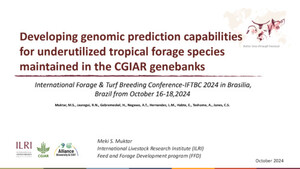
Utilization of molecular marker based genetic diversity patterns in hybrid parents to develop better forage quality multi-cut hybrids in pearl millet
Abstract
Genetic diversity of 130 forage-type hybrid parents of pearl millet was investigated based on multiple season data of morphological traits and two type of markers: SSRs (Simple sequence repeats) and GBS identified SNPs (Genotyping by sequencing-Single nucleotide polymorphism). Most of the seed and pollinator parents clustered into two clear-cut separate groups based on marker based genetic distance. Significant variations were found for forage related morphological traits at different cutting intervals (first and second cut) in hybrid parents; fresh/green forage yield (GFY) varied from 15 to 29 t ha-1 and 12 to 42 t ha-1 at first and second cut, respectively. Across two cuts, crude protein (CP) varied from 11 to 15%, while in vitro organic matter digestibility (IVOMD) varied from 51 to 56%. Eighty hybrids evaluated in multi-location trial along with their parents for forage traits showed that significant heterosis can be realized for forage traits. Low but positive significant correlation was found between SSR based genetic distance (GD between parents of hybrid) and heterosis for most of the forage traits. Results indicated that forage quality traits were linked to marker based clusters and this information can be further used for selecting parents for crossing purpose in breeding programs.
Citation
Ponnaiah, G., Gupta, S.K., Blümmel, M., Marappa, M., Pichaikannu, S., Das, R.R. and Rathore, A. 2019. Utilization of molecular marker based genetic diversity patterns in hybrid parents to develop better forage quality multi-cut hybrids in pearl millet. Agriculture 9(5):97.









